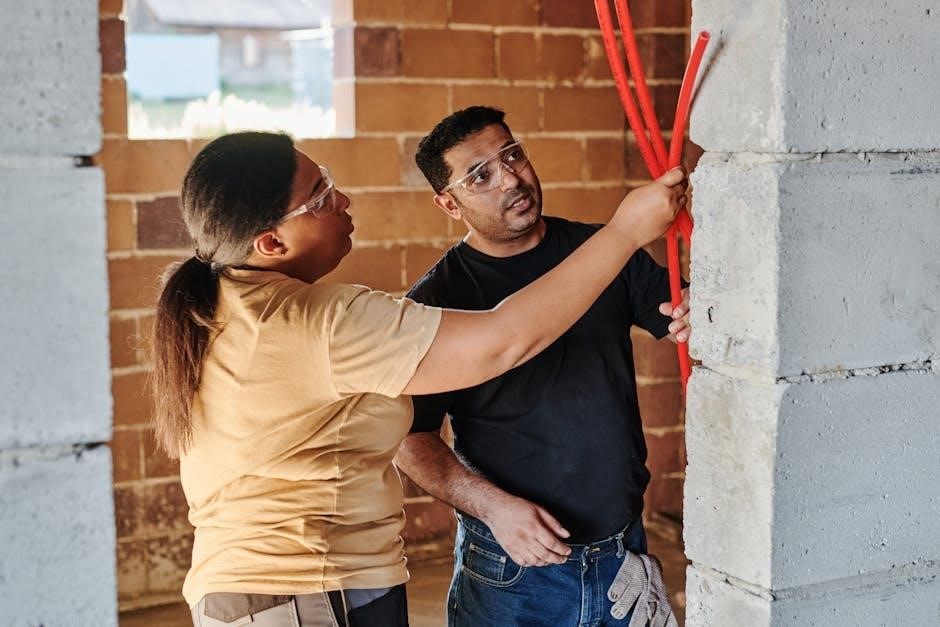1.1 Definition of a Manual Call Point (MCP)
A Manual Call Point (MCP) is a device that allows individuals to manually trigger a fire alarm, enabling quick response to emergencies.
A Manual Call Point (MCP) is a device designed to manually activate a fire alarm system in the event of a fire or emergency. Typically, it is a red box with a glass or plastic panel that, when broken, sends a signal to the fire alarm control panel. MCPs are essential in fire safety systems, enabling individuals to quickly alert others and initiate emergency responses. They are usually installed in strategic locations throughout buildings to ensure accessibility and rapid activation during emergencies. The simplicity and reliability of MCPs make them a critical component of fire safety protocols, allowing for immediate action to protect lives and property.
1.2 Role in Fire Safety Systems
Manual Call Points (MCPs) play a vital role in fire safety systems by providing a direct and reliable method for individuals to alert others in the event of a fire or emergency. Unlike automated fire detectors, MCPs rely on human intervention, ensuring that potential threats are not overlooked. By triggering an alarm manually, MCPs enable rapid response from emergency services and building occupants, critical in minimizing damage and ensuring safety. Their presence is mandated by fire safety regulations, emphasizing their importance as a fail-safe mechanism. MCPs are often integrated with fire alarm systems, ensuring seamless communication and activation of emergency protocols. This dual capability—manual and automated—enhances the overall effectiveness of fire safety strategies in various environments.

Design and Components
Manual Call Points (MCPs) are designed with a simple, durable mechanism to activate fire alarms. They typically include a resettable element, such as a button or handle, and status indicators like LED lights to confirm activation.
2.1 Physical Components of an MCP
Manual Call Points (MCPs) are constructed with durable materials to ensure reliability in emergency situations. The primary physical components include a resettable button or handle, often protected by a hinged cover to prevent accidental activation. Some models feature LED indicators to show the device’s status, such as whether it has been activated or requires maintenance. The internal mechanism typically includes a spring-loaded system that triggers the fire alarm when activated. MCPs are wired into the fire alarm system, connecting to a control panel that processes the signal. These components are designed to withstand regular use and environmental factors, ensuring the device remains functional when needed most.
2.2 Types of Manual Call Points
Manual Call Points (MCPs) are available in various designs to suit different environments and requirements. The most common type is the surface-mounted MCP, which is easily installed on walls or columns. Recessed MCPs are flush-mounted, providing a sleek appearance while maintaining functionality. Weatherproof MCPs are designed for outdoor or high-moisture areas, offering enhanced durability. Additionally, intelligent MCPs integrate with advanced fire alarm systems, providing precise location identification. Some models feature protective covers to prevent tampering or accidental activation. Each type is tailored to specific building needs, ensuring reliable performance in emergency situations. This diversity allows for flexible installation across various settings, from commercial spaces to industrial facilities.

Installation and Placement
Manual Call Points must be installed in visible, accessible locations, complying with local fire safety regulations to ensure quick activation during emergencies.
3.1 Building Regulations and Standards
Manual Call Points must comply with specific building regulations and fire safety standards, such as EN 54-11 in Europe, to ensure reliability and effectiveness. These standards dictate placement, visibility, and accessibility requirements. For instance, MCPs should be installed at a height no higher than 1.2 meters above floor level to ensure accessibility for all individuals. Additionally, they must be positioned in visible locations, such as near emergency exits or along escape routes, to maximize visibility during emergencies. Compliance with these regulations ensures that MCPs function as intended, providing a critical link between detection and response in fire safety systems. Regular testing and inspection are also mandated to maintain operational readiness.
3.2 Strategic Placement Guidelines
Manual Call Points should be strategically placed to ensure maximum visibility and accessibility in emergency situations. They are typically installed along escape routes, near emergency exits, and in high-traffic areas such as corridors, stairways, and main hallways. MCPs should be positioned at a consistent height, usually between 0.8 to 1.2 meters above floor level, to ensure they are easily accessible to all individuals, including those with disabilities. Additionally, they should be located within a reasonable distance from each other, typically no more than 30 meters apart in large buildings, to minimize response time. Avoid placing MCPs near obstacles or in areas prone to vandalism to ensure their reliability and effectiveness during emergencies.
3.3 Accessibility Considerations
Manual Call Points must be installed with accessibility in mind to ensure all individuals, including those with disabilities, can use them effectively. MCPs should be placed at a height that is easily reachable, typically between 0.8 to 1.2 meters above the floor, to accommodate people with mobility challenges. Clear signage, including visual and tactile indicators, should be provided to assist visually impaired individuals. Additionally, MCPs should be located in well-lit areas with unobstructed paths to ensure easy access. Regular testing and maintenance are crucial to guarantee functionality, as non-working devices undermine accessibility. By prioritizing accessibility, MCPs can serve as reliable tools for everyone in emergency situations.

Testing and Maintenance

Regular testing of MCPs ensures proper functionality, verifying that activation triggers the fire alarm system reliably. Visual inspections and functional checks are essential to maintain reliability and compliance.
4.1 Routine Testing Procedures
Routine testing of Manual Call Points (MCPs) is essential to ensure they function correctly in emergencies. Testing typically involves a visual inspection to check for damage or tampering, followed by physical activation to verify that the fire alarm system responds appropriately. The process may also include checking the integrity of wiring and connections. Additionally, the system’s response time and notification signals should be verified to ensure prompt emergency reactions. Testing frequency varies by regulations but is often recommended quarterly or as specified by local fire codes. Documentation of test results is critical for compliance and maintenance records. Any issues identified during testing must be addressed immediately to maintain system reliability and safety.
4.2 Common Issues and Troubleshooting
Common issues with Manual Call Points (MCPs) include faulty activation, wiring problems, or damage from tampering. Troubleshooting begins with a visual inspection to identify visible damage or wear. If activation fails, check the wiring connections for loose links or corrosion. Environmental factors like dust or moisture may also impair functionality. In such cases, cleaning or replacing components is necessary. If the issue persists, consulting the system’s manual or contacting a certified technician is recommended. Regular maintenance can prevent many of these problems, ensuring reliable operation during emergencies. Addressing issues promptly is crucial to maintain fire safety standards and avoid system failures.
4.3 Maintenance and Servicing Procedures
Regular maintenance of Manual Call Points (MCPs) is essential to ensure reliable performance. Inspect the device visually for signs of damage, wear, or tampering. Clean the components, including the contacts and terminals, to prevent dust or moisture interference. Check wiring connections for looseness or corrosion and secure them if necessary. Test the activation mechanism to confirm it triggers the fire alarm system correctly. Replace any worn or damaged parts promptly. Environmental factors, such as extreme temperatures or humidity, should be monitored to avoid degradation. Schedule professional servicing annually to ensure compliance with fire safety standards. Maintain records of all maintenance activities for audit purposes. Proper servicing ensures the MCP remains a critical, trustworthy component of fire safety systems.

Advantages of Manual Call Points
Manual Call Points (MCPs) offer reliability, simplicity, and cost-effectiveness, ensuring quick activation of fire alarms during emergencies, thus enhancing overall fire safety and response efficiency.
5.1 Reliability in Emergency Situations
Manual Call Points (MCPs) are designed to be highly reliable in emergency situations, ensuring immediate activation of fire alarms when needed. Their simplicity and robust construction make them resistant to failures, providing a dependable means of alerting others during a fire; MCPs are typically tamper-proof and designed to withstand environmental factors, ensuring they function reliably when activated. Their placement in accessible locations further enhances their effectiveness, allowing quick response to emergencies. This reliability is crucial for safeguarding lives and property, as delays in alarm activation can lead to severe consequences. MCPs are a critical component of fire safety systems, offering a consistent and trustworthy method for initiating emergency responses.
5.2 Cost-Effectiveness
Manual Call Points (MCPs) are a cost-effective solution for fire safety systems, offering a low-cost method for manual activation of fire alarms. Their simple design and minimal maintenance requirements reduce overall expenses, making them an economical choice for businesses and institutions. Unlike automated systems, MCPs do not require complex installations or high-energy consumption, further lowering costs. Additionally, their long lifespan and durability reduce the need for frequent replacements, contributing to long-term savings. This affordability ensures that MCPs remain a practical and accessible option for enhancing fire safety without incurring significant financial burdens. Their cost-effectiveness makes them a preferred choice for many organizations seeking reliable yet budget-friendly safety measures.
5.3 Contribution to Fire Safety
Manual Call Points (MCPs) significantly contribute to fire safety by providing a reliable means of manual fire alarm activation. Their presence ensures that individuals can quickly alert others in emergency situations, allowing for prompt evacuation and reducing potential damage. MCPs are strategically placed in accessible locations, making them easy to use during a fire. This immediate response capability enhances overall fire safety measures, ensuring that fire incidents are addressed swiftly. By enabling early detection and response, MCPs play a crucial role in minimizing risks to life and property. Their effectiveness in initiating timely alarms underscores their importance as a critical component of comprehensive fire safety systems.

Integration with Other Systems
Manual Call Points seamlessly integrate with fire alarm systems, building management systems, and emergency response systems, enhancing overall safety and enabling coordinated responses during emergencies.
6.1 Integration with Fire Alarm Systems
Manual Call Points (MCPs) are integral components of fire alarm systems, designed to trigger alarms manually in emergency situations. When activated, an MCP sends a signal to the fire alarm control panel, which then alerts the entire system. This integration ensures rapid notification of potential fires, enabling timely evacuations and response. MCPs are typically connected via wiring or wireless communication, ensuring reliable activation. Their role in fire alarm systems is crucial for identifying the location of a fire, as the signal from the MCP helps pinpoint the area of activation. This seamless integration enhances the overall effectiveness of fire safety protocols, ensuring that emergencies are addressed promptly and efficiently.
6.2 Connection to Building Management Systems
Manual Call Points (MCPs) can be integrated with Building Management Systems (BMS) to enhance monitoring and control of fire safety within a facility. The BMS acts as a central hub, overseeing various building functions, including fire alarms, HVAC, and security systems. When an MCP is activated, it sends a signal to the BMS, which processes the information to trigger appropriate responses, such as activating alarms, isolating affected areas, or notifying emergency services. This integration ensures real-time monitoring and efficient incident management. By linking MCPs to the BMS, facilities can streamline emergency protocols, improve response times, and maintain a safer environment for occupants. This connectivity also supports automated alerts and status updates, enhancing overall system reliability and maintenance efficiency.
6.3 Role in Emergency Response Systems
Manual Call Points (MCPs) play a critical role in emergency response systems by providing a reliable means to initiate an alarm in the event of a fire or other emergency. Their visibility and accessibility ensure that individuals can quickly alert others, triggering a prompt response. When activated, MCPs send signals to the fire alarm system, which then notifies emergency services and building occupants. This immediate action helps contain incidents and prevents escalation. MCPs are integral to ensuring timely evacuation and emergency intervention, making them indispensable in safeguarding lives and property. Their integration with broader emergency response protocols enhances overall safety measures, ensuring a coordinated and effective reaction to potential threats.

Legal and Compliance Aspects
Manual Call Points must comply with fire safety regulations, such as EN 54 or NFPA 72, ensuring reliability and proper functionality in emergencies. Regular inspections are mandated.
7;1 Relevant Fire Safety Regulations
Manual Call Points (MCPs) are governed by fire safety regulations such as EN 54 in Europe and NFPA 72 in the U.S., ensuring their reliability and effectiveness. These standards dictate design, installation, and testing requirements to guarantee proper functionality during emergencies. Compliance with these regulations is mandatory for building safety and to avoid legal penalties. Regular inspections and maintenance are also required to ensure MCPs remain operational. These regulations ensure that MCPs are strategically placed, easily accessible, and capable of withstanding various environmental conditions. Adherence to these standards is critical for maintaining fire safety integrity in commercial and residential properties. Non-compliance can result in legal consequences and compromised safety.
7.2 Compliance Codes and Standards
Manual Call Points must comply with specific codes and standards to ensure effectiveness and reliability. In Europe, EN 54-11 outlines the requirements for manual call points, including their design, functionality, and testing. In the U.S., NFPA 72 provides detailed guidelines for installation, inspection, and maintenance. These standards ensure that MCPs are visible, accessible, and tamper-proof, with clear indicators for activation. Compliance also involves regular testing, such as weekly inspections and annual certifications, to maintain operational readiness. Adhering to these codes ensures that MCPs integrate seamlessly with fire alarm systems, providing reliable emergency response capabilities. Non-compliance can lead to system failures and legal repercussions, emphasizing the importance of strict adherence to these standards.
7.3 Penalties for Non-Compliance
Non-compliance with fire safety regulations regarding Manual Call Points can result in severe penalties. These may include hefty fines, legal actions, and even shutdowns of non-compliant buildings. Authorities enforce strict adherence to codes like EN 54-11 in Europe and NFPA 72 in the U.S. Failure to install, maintain, or test MCPs properly can lead to legal repercussions. Additionally, non-compliance may void insurance coverage in the event of a fire. Penalties also extend to reputational damage, as businesses may face public scrutiny for neglecting safety standards. Regular inspections and adherence to legal requirements are essential to avoid such consequences and ensure public safety. Compliance is not optional; it is mandated by law to protect lives and property.

Troubleshooting Common Issues
Identifying faults in Manual Call Points involves checking activation failures, wiring issues, and wear. Regular maintenance ensures reliable operation and prevents system malfunctions during emergencies.
8.1 Identifying Faults in MCPs
Identifying faults in Manual Call Points involves checking for activation failures, wiring issues, and wear. Common faults include failure to trigger the alarm, faulty switches, or damaged cables; Symptoms may include unresponsive buttons, irregular LED illumination, or system errors. Regular inspections and testing are crucial to detect these issues early. Faulty MCPs can lead to delayed emergency responses, making troubleshooting essential for system reliability. Inspecting wiring connections, testing activation mechanisms, and ensuring proper installation are key steps. If issues persist, replacing defective components or entire units may be necessary to maintain fire safety integrity. Timely identification prevents potential system malfunctions during critical situations.
8.2 Step-by-Step Troubleshooting Guide
To troubleshoot Manual Call Point faults, start by checking activation functionality. Ensure the button activates and resets properly. Next, inspect wiring connections for damage or loose links; Verify power supply to the MCP, as low voltage can cause malfunctions. Test the activation mechanism for smooth operation and check for physical damage or wear. If issues persist, consult the manufacturer’s manual for specific guidance. Replace faulty components or the entire unit if necessary. Regular testing and inspections can prevent recurring issues. Always follow safety protocols when handling electrical components. If unsure, contact a certified technician for assistance. Proper troubleshooting ensures reliable operation of fire safety systems.

Case Studies and Real-World Applications
Manual Call Points are widely used in schools, hospitals, and offices. Their effectiveness in real fire incidents highlights their critical role in emergency response systems.
9.1 MCPs in Various Building Types
Manual Call Points are essential in schools, hospitals, and offices, ensuring quick fire alarm activation. In schools, they are often near exits or corridors, while hospitals place them in patient areas or near emergency exits. Offices typically locate MCPs in common areas or stairwells. Their strategic placement ensures rapid response, critical in minimizing fire hazards. MCPs in large commercial buildings are often networked for precise location identification. Residential buildings may also use MCPs, especially in multi-unit complexes. Their effectiveness has been proven in numerous fire incidents, demonstrating their reliability across diverse settings. Proper placement and compliance with regulations ensure safety and efficiency in emergency situations.
9.2 Lessons Learned from Fire Incidents
Fire incidents have highlighted the critical role of Manual Call Points (MCPs) in ensuring timely evacuation and response. In a school fire, an MCP quickly alerted authorities, preventing injuries. Similarly, in a hospital, an MCP triggered a swift evacuation, saving lives. However, incidents where MCPs were absent or improperly placed led to delayed responses and increased damage. These lessons underscore the importance of strategic placement and regular maintenance. Properly functioning MCPs have proven instrumental in minimizing fire-related risks, emphasizing their value in fire safety systems. These real-world examples reinforce the need for adherence to installation and maintenance standards to maximize their effectiveness in emergencies.
Manual Call Points are essential for initiating fire alarms in emergencies, ensuring timely responses. Their reliability and cost-effectiveness make them indispensable in safeguarding lives and property. Future innovations will enhance their functionality further.
10.1 Importance of MCPs in Fire Safety
Manual Call Points (MCPs) are critical components in fire safety systems, enabling individuals to manually trigger alarms during emergencies. Their visibility and accessibility ensure rapid response, minimizing potential damage and loss. By providing a reliable means to alert others, MCPs play a pivotal role in safeguarding lives and property. Their importance lies in their ability to initiate timely evacuation and emergency services’ response, making them indispensable in fire safety strategies. MCPs are essential for early detection and activation, ensuring swift action to contain fires effectively. Their presence in buildings underscores their vital contribution to overall fire safety, highlighting their necessity in modern safety protocols.
10.2 Future Trends and Innovations
The future of Manual Call Points (MCPs) lies in integration with advanced technologies, enhancing their role in fire safety systems. Innovations such as addressable MCPs, which provide precise location identification, are becoming more prevalent. Smart MCPs with IoT connectivity could offer real-time monitoring and predictive maintenance, ensuring optimal functionality. Energy-efficient designs, such as solar-powered MCPs, are also emerging to reduce environmental impact. Additionally, advancements in materials and manufacturing are expected to improve durability and aesthetics. Future MCPs may also incorporate touchless activation or voice-activated systems for enhanced accessibility. These innovations aim to maintain MCPs as critical, reliable components in modern fire safety, adapting to technological and regulatory advancements while ensuring user safety and convenience.




About the author